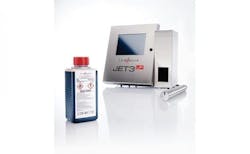Heat-Resistant Printing Ink
A stream of red lava can run as high as between 600 and 900°. And things can get even hotter in industrial settings – for example, in a ceramic furnace. Only very few inks for component-marking with CIJ printers can withstand these extreme temperatures. With this in mind, a heat-resistant ink for the JET3up PI was developed.
Heat-resistant ink is a pigmented ink. Black color particles float in a medium – unlike a dye ink in which the dye is dissolved in the medium and evaporates immediately at extreme temperatures. The experts succeeded in modifying the pigment ink’s particles and medium in such a way that they can withstand heat of up to 1000°C – unscathed. They also found a way to keep the particles in suspension through chemical stabilization. This slows down the so-called sedimentation process, in which the pigments settle. Additionally, the JET3up PI CIJ printer incorporates a stirring mechanism that continuously mixes the ink. The combination of chemical stabilization and stirring mechanics ensures a reliable and low-maintenance labeling system.
The heat-resistant pigment ink is designed for the JET3up PI – a printer that marks products without contact using the so-called Continuous Inkjet (CIJ) technology. In the printhead, an ink jet, consisting of up to 96,000 electrically charged single drops per second, shoots through a nozzle. When printing, a high-voltage field changes the trajectory of individual drops, so that they end up as pixels on the product surface. The remaining drops fly into a catcher tube and are sucked back into the continuously circulating hydraulic circuit and used there. The printing technology is fast enough to keep up with conveyor belt speeds of up to 10 m/s and is also extremely cost-effective. The CIJ printer can print up to 120 million letters with one single liter of ink.
